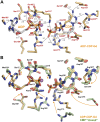The crystal structures of Thermus thermophilus CMP kinase complexed with a phosphoryl group acceptor and donor
- PMID: 32469932
- PMCID: PMC7259600
- DOI: 10.1371/journal.pone.0233689
The crystal structures of Thermus thermophilus CMP kinase complexed with a phosphoryl group acceptor and donor
Abstract
Nucleoside monophosphate kinases play crucial roles in biosynthesis and regeneration of nucleotides. These are bi-substrate enzymes that catalyze reversible transfers of a phosphoryl group between ATP and nucleoside monophosphate. These enzymes are comprised of the CORE domain, the NMP-binding domain, and the LID domain. Large conformational rearrangement of the three domains occurs during the catalytic cycle. Although many structures of CMP kinase have been determined, only limited structural information has been available on the conformational changes along the reaction pathway. We determined five crystal structures of CMP kinase of Thermus thermophilus HB8 in ligand-free form and the CMP "open", CMP "closed", ADP-CDP-Gd3+-, and CDP-bound forms at resolutions of 1.7, 2.2, 1.5, 1.6, and 1.7 Å, respectively. The ligand-free form was in an open conformation, whereas the structures of the CMP "closed", ADP-CDP-Gd3+-, and CDP-bound forms were in a closed conformation, in which the shift of the NMP-binding domain and LID domain caused closure of the substrate-binding cleft. Interestingly, the CMP "open" form was in an open conformation even with CMP bound, implying intrinsic conformational fluctuation. The structure of the ADP-CDP complex is the first structure of CMP kinase with a phosphoryl group donor and an acceptor. Upon simultaneous binding of ADP and CDP, the side chains of several residues in the LID domain moved toward the nucleotides without global open-closed conformational changes compared to those in the CMP "closed" and CDP complexes. These global and local conformational changes may be crucial for the substrate recognition and catalysis. The terminal phosphate groups of ADP and CDP had similar geometry to those of two ADP in AMP kinase, suggesting common catalytic mechanisms to other nucleoside monophosphate kinases. Our findings are expected to contribute to detailed understanding of the reaction mechanism of CMP kinase.
Conflict of interest statement
The authors have declared that no competing interests exist.
Figures













Similar articles
-
The crystal structure of Thermus thermophilus UMP kinase complexed with a phosphoryl group acceptor and donor.PLoS One. 2025 Sep 2;20(9):e0330398. doi: 10.1371/journal.pone.0330398. eCollection 2025. PLoS One. 2025. PMID: 40892736 Free PMC article.
-
Structures of escherichia coli CMP kinase alone and in complex with CDP: a new fold of the nucleoside monophosphate binding domain and insights into cytosine nucleotide specificity.Structure. 1998 Dec 15;6(12):1517-27. doi: 10.1016/s0969-2126(98)00150-6. Structure. 1998. PMID: 9862805
-
Substrate-induced fit of the ATP binding site of cytidine monophosphate kinase from Escherichia coli: time-resolved fluorescence of 3'-anthraniloyl-2'-deoxy-ADP and molecular modeling.Biochemistry. 2000 Dec 26;39(51):15870-8. doi: 10.1021/bi0015360. Biochemistry. 2000. PMID: 11123913
-
Structural and functional roles of dynamically correlated residues in thymidylate kinase.Acta Crystallogr D Struct Biol. 2018 Apr 1;74(Pt 4):341-354. doi: 10.1107/S2059798318002267. Epub 2018 Apr 6. Acta Crystallogr D Struct Biol. 2018. PMID: 29652261
-
Respiratory complex I: mechanistic and structural insights provided by the crystal structure of the hydrophilic domain.Biochemistry. 2007 Mar 6;46(9):2275-88. doi: 10.1021/bi602508x. Epub 2007 Feb 3. Biochemistry. 2007. PMID: 17274631 Review.
Cited by
-
The mechanism of Raf activation through dimerization.Chem Sci. 2021 Nov 18;12(47):15609-15619. doi: 10.1039/d1sc03444h. eCollection 2021 Dec 8. Chem Sci. 2021. PMID: 35003591 Free PMC article.
-
Characterizing a novel CMK-EngA fusion protein from Bifidobacterium: Implications for inter-domain regulation.Biochem Biophys Rep. 2022 Dec 16;33:101410. doi: 10.1016/j.bbrep.2022.101410. eCollection 2023 Mar. Biochem Biophys Rep. 2022. PMID: 36578527 Free PMC article.
References
Publication types
MeSH terms
Substances
LinkOut - more resources
Full Text Sources
Research Materials

